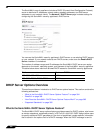
Network > DHCP Server
385
SonicOS 5.8.1 Administrator Guide
clients on the network, it provides vendor-specific configuration and service information. The
“DHCP Option Numbers” on page 400 provides a list of DHCP options by RFC-assigned option
number.
Benefits
The SonicWALL DHCP server options feature provides a simple interface for selecting DHCP
options by number or name, making the DHCP configuration process quick, easy, and
compliant with RFC-defined DHCP standards.
How Does the SonicWALL DHCP Server Options Feature Work?
The SonicWALL DHCP server options feature allows definition of DHCP options using a drop-
down menu based on RFC-defined option numbers, allowing administrators to easily create
DHCP objects and object groups, and configure DHCP generic options for dynamic and static
DHCP lease scopes. Once defined, the DHCP option is included in the options field of the
DHCP message, which is then passed to DHCP clients on the network, describing the network
configuration and service(s) available.
Supported Standards
The SonicWALL DHCP server options feature supports the following standards:
• RFC 2131 - Dynamic Host Configuration Protocol
• RFC 2132 - DHCP Options and BOOTP Vendor Extensions
Multiple DHCP Scopes per Interface
The following sections provide an overview of the Multiple DHCP Scopes per Interface feature:
• “What are Multiple DHCP Scopes per Interface?” on page 385
• “Benefits of Multiple DHCP Scopes” on page 385
• “How Do Multiple DHCP Scopes per Interface Work?” on page 386
What are Multiple DHCP Scopes per Interface?
Often, DHCP clients and server(s) reside on the same IP network or subnet, but sometimes
DHCP clients and their associated DHCP server(s) do not reside on the same subnet. The
Multiple DHCP Scopes per Interface feature allows one DHCP server to manage different
scopes for clients spanning multiple subnets.
Benefits of Multiple DHCP Scopes
Efficiency – A single DHCP server can provide IP addresses for clients spanning multiple
subnets.
Compatible with DHCP over VPN – The processing of relayed DHCP messages is handled
uniformly, regardless of whether it comes from a VPN tunnel or a DHCP relay agent.
Multiple Scopes for Site-to-Site VPN – When using an internal DHCP server, a remote subnet
could be configured using scope ranges that differ from the LAN/DMZ subnet. The scope range
for the remote subnet is decided by the “Relay IP Address” set in the remote gateway.


















